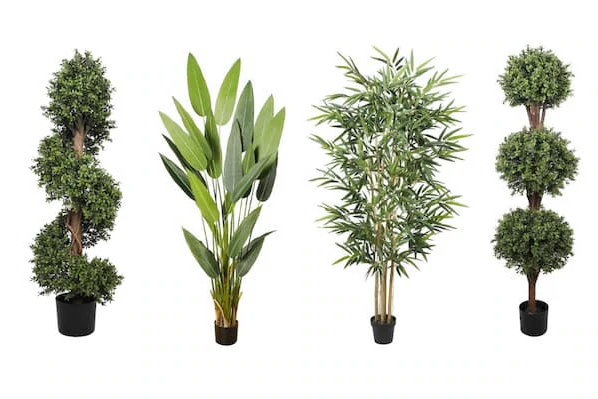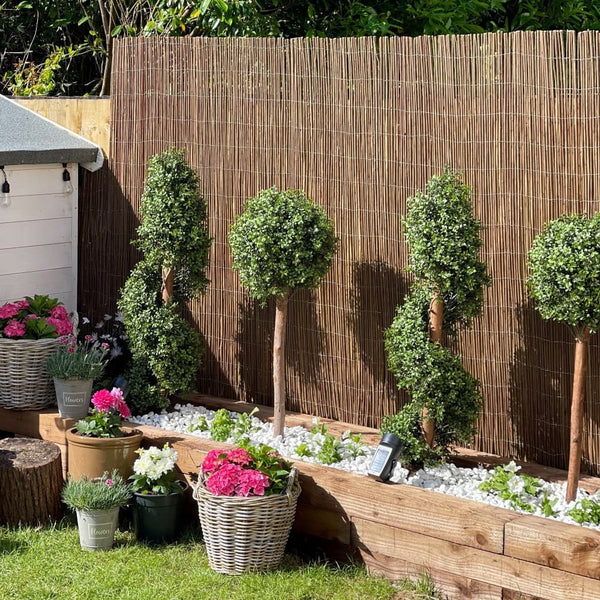
7 Things to Consider Before Buying Outdoor Artificial Trees
Can buying outdoor artificial trees be as simple as jumping online for 10 minutes and buying the first ones you like? Sure, buuuttt you may end up with some regrets. Choosing the right artificial trees requires a little more forethought if you want long-lasting trees that look good day after day, year after year.
In this article, we’ll guide you through everything you need to know before investing in artificial trees for your outside space, whether that’s your driveway, back garden, or place of business.
7 Things to Consider Before Buying Outdoor Artificial Trees
1. Things Your Outdoor Artificial Trees Must HaveThe first thing we need to talk about, and also the biggest mistake people make, is not thinking to look for UV protection or thinking about how the plant’s materials are going to fair outside. Not all artificial trees are suitable for outside use - yes, they’re artificial, but that doesn’t necessarily mean they’re going to be able to withstand the weather.
So, what do you need to look for? Any product page you look at should have two things:
- Say it’s suitable for outside use
- Say it has UV protection or is made from UV-resistant materials
Without these two things, one sunny summer or one winter and it will look more like a forgotten artificial plant in a graveyard than a beautiful, thriving live plant.
When a plant says it’s suitable for outside use, the manufacturer has considered carefully what materials will survive the changing weather conditions well. Silk is a popular choice of material for leaves and petals on indoor artificial plants, but it doesn’t do well outside.
A UV-protected plant means it has a special coating or additive that helps protects the pigments in the plant from fading. Anything artificial fades with time, but a UV-protected plant means it won’t for a long time. You can also get UV protection sprays, which can be applied to your outdoor artificial plants once a year to keep the UV protection high.

2. Location
Now you know the basics of what to buy and what not to, we can start considering all the other factors of buying artificial plants - many of which come down to personal preference.
The first to consider is the space you’re trying to fill. You can buy first, and find a place later–and sometimes that totally works–but it’s best to have a vision and find the plants to match. After all, artificial plants don’t change over time, so you can bring your vision to life immediately and not have to wait for things to grow or worry about what you’re going to do when the plant gets too big for its boots.
There really aren’t any rules when it comes to location (you can even plant them in the ground in many circumstances), but go in with a plan. You can find plenty of ideas on Instagram and Pinterest, and you can find more detailed styling guides on our Blog.
The one tip we can give you here is unless you are going for a symmetrical look (such as two plants on either side of a doorway or plants lining a path) opt for odd numbers. One tall feature plant or a group of 3 or 5 usually looks best - this goes for mixed groups as well.

3. The Different Types of Outdoor Trees
Once you’ve got an idea of where you want your outdoor artificial trees to go, it’s time to decide what it’s going to look like. Here are some of the most popular choices:
- Boxwood - Boxwood is by far the most popular choice; it’s the small, dense hedge-like foliage that is used for topiary trees. You can find outdoor artificial boxwood trees in the following shapes: cone, single ball, spiral, and triple ball. You may also be able to find more elaborate topiary designs, but these are usually smaller bushes.
- Cypress - Cypress is another style of evergreen outdoor artificial tree, and it has a softer, bushier look than Boxwood trees. Cypress outdoor artificial trees are usually in longer shapes over balls, so you can find them in spirals, cones, and similar shapes.
- Bay - Bay trees are usually styled in single ball style trees, but you can find them in other shapes.
- Conifer- another option if you want to lean towards the realism evergreen plants bring. The only downside to conifers is they can look just like a Christmas tree, so make sure the one you choose is a little bushier than the typical Christmas tree.
- Palm - You can find versions of palm trees that are suitable for outside use if you want to create a tropical feel.
- Bamboo - Bamboo plants are perfect for screening, whether it be to separate areas of your garden or to shield you from neighbours. Just make sure the bamboo plant you’re looking at are suitable for outdoor use, as most aren’t.

4. Size
When it comes to outdoor artificial trees, don’t be afraid to go big! Unless you’re specifically looking for trees to frame a doorway that’s essentially right on the street, you don’t want to think small. And, even if that is the case, Boxwood and Cypress artificial trees come in tall-yet-narrow styles (such as spirals), which will fit outside most doors.

5. Anchoring and Severe Weather
We generally get a severe storm once or twice a year, so it’s best to have a contingency plan for those times, but anchoring is important for normal wind too.
For extreme weather conditions, namely strong winds, consider bringing your artificial plants inside if you can. Just like real plants, artificial plants may be damaged by strong winds, but unlike live plants, they won’t eventually grow back.
You may be able to take this advice with a pinch of salt if you live in a sheltered area, or if your artificial plant will be living in a sheltered area, but bringing plants in or even laying them flat on the ground for the storm will ensure you don’t have to pay for a replacement. Most of our plants have a manufacturer’s warranty, but that’s to cover premature aging and breakages, not storm damage.
Outdoor artificial trees can withstand normal winds and gusts, so you just need to anchor them appropriately. Make sure the base of their pot is weighed down properly or consider filling the pot with sand, pebbles, or similar. You can follow our full re-potting guide here.

6. Choosing the Right Container
We’ve written a complete guide on how to choose the best planter for your artificial plants and trees, so we’ll keep this section brief. All outdoor artificial trees come with a built-on fixed plastic pot, but they’re usually not designed to be the “main” pot - they’re essentially just a base. So, you’ll need another container.
The world is your oyster here, the only thing your container must have is drainage. Unless your artificial plant is going to be on a covered patio with no chance of it getting wet, it must have an area for the water to drain out. Otherwise, you’ll end up with more of a pond than a plant, and your artificial plant may get mold or algae on it. Not stylish.
The best materials to look for for outdoor artificial trees are:
- Terracotta
- Glazed Terracotta
- Wood
- Fiberglass
- Recycled Plastic
- Concrete
- Ceramic
- Metal
- Slate
We explain the pros and cons of all these materials in our planter guide, so head over there if you haven’t already.
In terms of sizing, your only guide is not to go too small - your artificial plants don’t need any space more than the space needed for their fixed pot and some materials to keep the weight in the base of the bottom of the pot and whatever you use to keep them upright (see our re-potting guide for advice on this). That said, you also need to think about proportions - we’ve got a complete size guide in our planter guide here.

7. Price
Nowadays, it’s actually difficult to find stiff, plasticky artificial plants with the plastic molding showing, but that’s not to say that all outdoor artificial plants are of equal quality. Like everything else in life, you get what you pay for. Remember that if you want your artificial outdoor plants to look as good a few years down the line as they do when you plant them, you’ll need to invest in quality.
Outdoor Artificial Trees FAQ
Can you plant outdoor artificial trees in the ground?
You can! The only caveat is to ensure the area has good drainage, especially at the base of the plant stem. If the stem is real wood, it may be best to use some pebbles or gravel around the base of the stem and soil around them. This will be less necessary in a very sunny spot than it will be in a dark corner.
Consider how wet the area gets and, more importantly, stays, before simply planting in soil and walking away. If the stem gets wet often and stays moist, it may grow algae or even rot prematurely. Consider treating the base of the plant with a clear sealant to prevent this if you want to plant it in a typically dark and moist area.
What are outdoor artificial plants made from?
It varies depending on the manufacturer, but generally they’re made from synthetic materials, though some have real wood stems. To find out more about what artificial plants are made from, read our guide here.
What kind of maintenance do I need to do for outdoor artificial trees?
Generally, outdoor artificial trees require no maintenance - after all, that’s why you’re investing in them, right? You don’t need to clear up dead leaves, you don’t need to worry about disease, and you don’t need to prune them. To ensure they look their best for as long as possible, follow these tips:
- Make sure the stem has plenty of drainage if it is real wood.
- Reapply UV protection (easily done with a spray) every 6-12 months, especially after the first year.
- Make sure any pot or container you choose has a drainage hole (unless it’s completely under cover).
- Consider bringing the plant inside or laying it on the ground for severe storms - if real trees are likely to be affected, your artificial plant may be too.
- If you store your plant in between uses, put it back in the box it came in or wrap it in a blanket, making sure all the leaves are pointing up so they are easy to arrange and not damaged when you get it out again. If you’re putting it in a box, open both ends and pull the plant in via its base.
Outdoor artificial trees are a great way to bring life to your outside spaces without the hassle of live plants. However, if you want them to look as good as possible and indistinguishable from live plants, you need to follow the tips and make the 7 considerations we’ve discussed in this article. Don’t forget that you aren’t limited to outdoor artificial trees! There are also artificial outdoor hanging baskets, outdoor green walls, and small plants that are all suitable for bringing your outside space to life. To explore our range of outdoor plants, click here.

Leave a comment